Look at these tiny colorful babies! If you adore cacti as much as we do, you must add a Moon cactus to your collection. Moon cacti are very easy to grow and care for, keeping their small size for a very long time. Also, they can fill any empty spot on your desk or your windowsill and brighten your day.
Gymnocalycium mihanovichii, also known as Moon Cactus, Ruby Ball, Hibotan Cacti, Red Cap, or Red Hibotan, is a species of cactus from the Cactaceae family. Moon Cactus is native to desert regions of South America, such as northeast Argentina, Brazil, Paraguay, and Bolivia. It grows at lower elevations up to 500 meters.
This species was first discovered by Alberto Vojtěch Frič, a Czech botanist, ethnographer, and explorer, in 1903. Later, in 1905, it was described by Max Gürke as Echinocactus Mihanovichii and placed in the Gymnocalycium genus in 1922.
About Moon Cactus
- This versatile cactus needs a mix of bright light and partial shade because it consists of two cacti with pretty different needs. Choose a spot that can comfort both of them.
- They do well in average room temperatures and low humidity levels. During the winter, keep these plants indoors to protect them from frost.
- Moon cacti are tolerant of drought, so they do not need regular watering. Check the soil in-between waterings to make sure it is nearly dry. Increase the frequency of watering during the summer and cut back on watering the cactus in winter.
- It is better to water these cacti rarely than to over-water them, as this may cause root problems that can affect their overall health.
- Moon cacti are slow growers, which makes them the perfect choice if you don’t want to worry about repotting.
- During the growing season, it is recommended you use a cactus fertilizer once a month for optimal growth. Skip the feeding over the dormant season.
- Generally, these cacti are not toxic to cats, dogs, or humans. Their thorns, however, are a bit sharp, so it’s best to handle it with care. You can place them near pets and children without any worries, as they will not harm them in any way as long as they don’t touch the thorns.

Moon Cactus Features: An Overview
- The most common cultivars of this species are different mutant variations. Growers will often graft them onto other cacti to obtain interesting specimens.
- These cacti are unable to produce chlorophyll, but they can exhibit red, yellow, or orange pigmentation.
- The colorful part (the scion) of the Moon cactus is Gymnocalycium Mihanovichii, while the lower host can be any species of cacti, but is usually a Hylocereus cactus.
- Although many people mistake the top layer of Moon cacti with their flowers, they can bloom if you are patient enough. Their bloomings are different shades of pink and are really pretty.
- Depending on the rootstock, Moon Cacti can reach various heights but they usually stop growing once they reach around 4 inches (10 cm). The diameter of the Moon cactus is between 1.1 and 1.9 inches (3-5 cm).
- Generally, they have 8 to 14 slightly-notched ribs with narrow edges. Their average 5-6 thorns are weak, flexible, slightly-curved, and greyish-yellow.
- They can be paired with the Schlumbergera (known as Thanksgiving, Christmas, or Easter cactus) species, as both have similar requirements regarding the environmental conditions.

Growing Moon Cactus
In terms of growing and caring, Moon cacti species are similar to most succulents and cacti. If you already know how to grow succulents and other species of cacti, Moon cacti will not cause any trouble. However, even in good care conditions, they can only live for a few years. But they are worth all the effort!
They are mutant specimens that combine two cacti species with different preferences of light. Although they grow together, their relationship is a parasitic one. To keep both of them in good shape, their needs must be met. While the bottom green cactus is a light-lover in most cases, the colored one on top will not tolerate direct sunlight.
When growing these cacti, make sure you place them in a slightly bright spot that provides them with plenty of partial shade. Too much bright and direct light may cause the top layer to lose its color over time.
Like all cacti, Moon cactus is tolerant of long periods of drought and it thrives in desert-like conditions. It can do well in the average indoor temperatures, but you should keep it away from temperature values that drop below 40 °F (4 °C). Moon cacti will not survive frost, so a light blanket or a sheet can be very efficient to protect them during the winter.
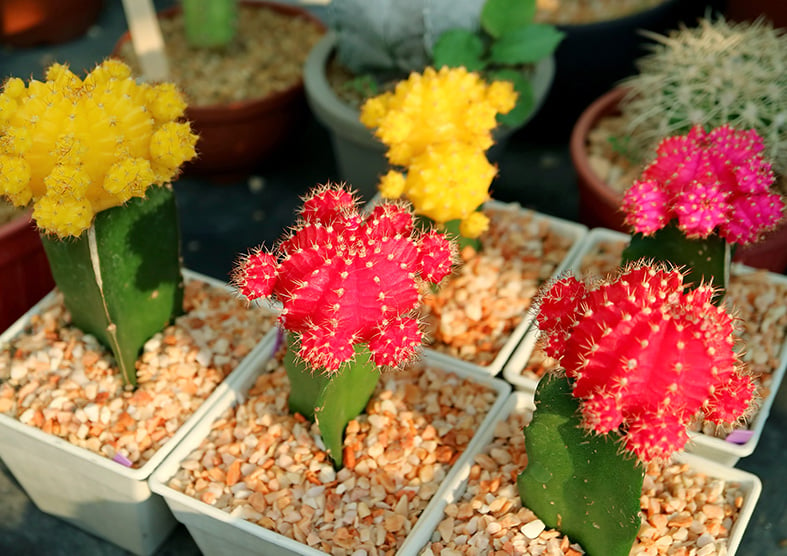
When first planting a Moon cactus, you need to choose a potting soil mix that is ideal for the bottom cactus. Usually, the host prefers a cactus soil mixt hat is rich in organic matter and fast-draining, and that has low pH levels (acidic to neutral).
These cacti don’t really need fertilizers, but they enjoy a nice feeding during their growing season, from April to September. You can feed your plant with a cactus fertilizer once every month and stop fertilizing over the winter months.
If you want to repot your Moon cactus, it is better to do so during the warm season. Wait for the potting soil to dry out completely and gently take the cactus out of the pot. Remove the excess soil around your cactus and trim any rotten or dead roots.
If any cuts have been made, make sure you treat them with a fungicide. Fill the container with fresh cactus potting mix and plant your Moon cactus in it with its roots spread out. Do not water your freshly repotted cactus for about a week because immediate watering can result in root rot.
The pests are not a big concern regarding these cacti, but mealybugs or spider mites may show up once in a while. Once you notice a possible infestation, you need to quarantine your cactus and remove any insects with a cotton cloth dipped in rubbing alcohol. Also, you can control these kinds of infestations using systemic pesticides or high concentrations of contact insecticides.
- REAL CACTUS PLANT PACK: Enjoy a colorful assortment of grafted cacti with white pots. Display as plant decor for bedroom spaces or a low-maintenance office plant.
- GIFT FOR PLANT LOVERS: These colorful plants are low-maintenance, making them a great plant gift for anyone. Create a cactus and succulent gift basket or DIY cactus kit with cactus potting soil and cactus fertilizer to help these plants thrive.
- CACTUS DECOR: Showcase these potted plants and decorative succulent planters alongside many cacti & succulent plants, such as a jade plant, Aloe Vera plant, pothos, terrarium plants and other indoor plants.
- EASY TO GROW HOUSE PLANTS: Arrange these popular houseplants with other drought tolerant plants, a desktop succulent or with your favorite desk plant. Live indoor house plants like a snake plant, zz plant, peace lily, parlor palm and other decorative plants.
- LIVE PLANTS AT YOUR DOOR: Your live plant delivery includes a variety of 3 grafted, fully-rooted cacti in 3 inch white planters.
- HIGH QUALITY: Fully Rooted Red Graft Cactus. Picked from Our Greenhouses the Same Day We Ship.
- PLANT SANCTUARY: Create the Indoor or Outdoor Space of Your Dreams with Live Moon Cactus Plants.
- FAMILY FARM: We Have Over 55 years of Experience Growing Healthy Large Moon Cactus Plants.
- LOW MAINTENANCE: Only Water You’re Live Moon Cactus Plants Once Every 2-3 Weeks.
- WATER WISE: Moon cactus plants require minimal water compared to other indoor or outdoor plants that need daily watering.
Last update on 2024-10-01 / Affiliate links / Images from Amazon Product Advertising API
Watering Moon Cactus
Because the bottom half of this cactus is perfectly adapted to drought, the Moon cactus doesn’t require a lot of attention when it comes to watering. These cute cacti will forgive you when you if you neglect them for a while.
However, if you live in a warm area and you need to water them regularly, make sure you check the soil first, as they will not appreciate a swampy soil for more than a day. Allow the soil to dry almost entirely before you add more water.
Plant these cacti in containers with drainage holes to avoid prolonged exposure to moisture. If you grow your Moon cacti in a small pot, it will be more than enough if you water it once a week. Be careful not to over-water your cactus, as it is very susceptible to root rot.
During the warm summer months, you might need to increase the frequency of watering, especially if you are growing your cacti outdoors. When winter settles in, you can skip the watering, but take some time to occasionally mist your cactus.
Like most cacti, they do well in places with low levels of humidity. To maintain the ideal amount of moisture you can use a dehumidifier. You can also try placing your Moon cactus in a room with air vents.
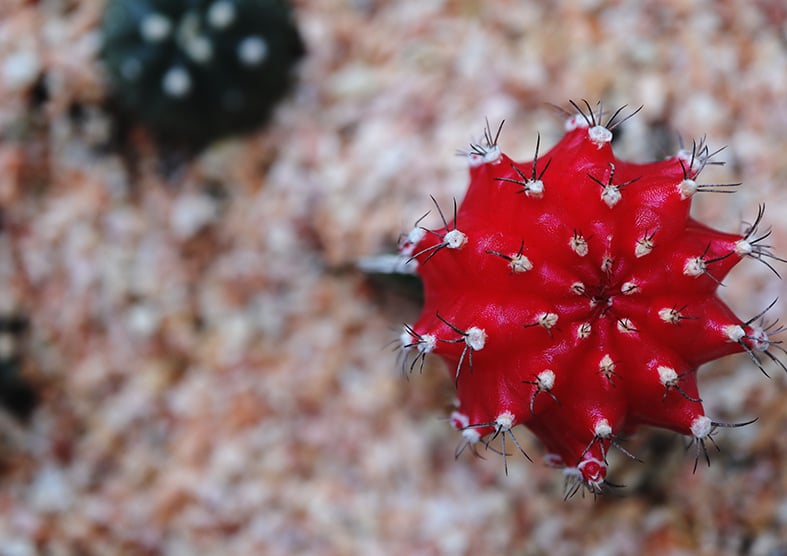
Propagating Moon Cacti
These cacti are not appropriate for propagation, but you can learn how to graft a Moon cactus at home. Many species of cacti can be grafted easily. This process is pretty simple and any gardener can do it, be it a beginner or an experienced one. You should not be intimidated by their inoffensive thorns!
Cut the scion from the old rootstock and the upper layer of the seedling cactus using a sharp and sterilized knife. You will notice a circle-shaped vascular tissue on the scion and the new host cactus. Bring the scion closer to the host and try to align their vascular tissues.
Once they are aligned, wrap the scion cactus and the bottom of the container in which the host is growing vertically, with rubber bands. Wait for the tissues to fuse and remove the rubber bands.
If you are lucky enough to grow a certain specimen of Moon cactus that produces offsets, you can propagate the plant once it reaches maturity. Some Moon cacti scions may produce offsets in clusters that you can easily separate from the mother plant. Carefully remove one offset and allow it to dry for about one or two days. You can then plant it in well-draining potting soil. But keep in mind that it will eventually need a host cactus to survive.
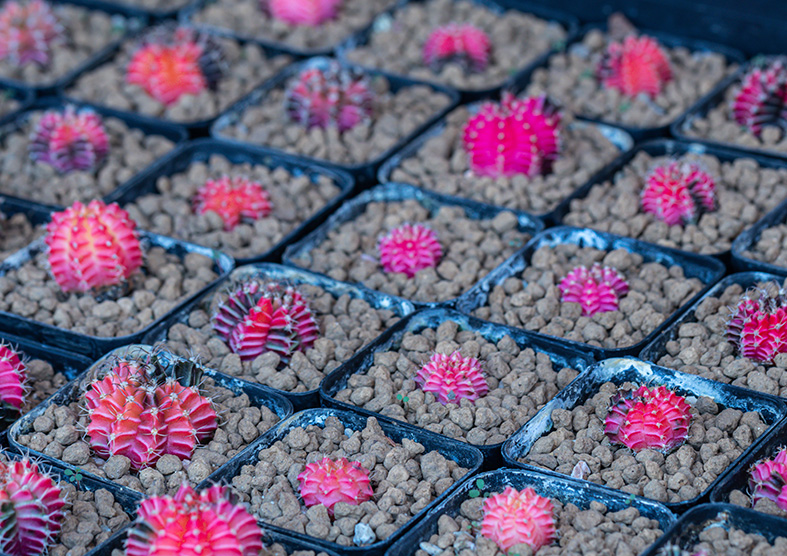
In Conclusion
Moon cacti are irresistible. So, if you happen to stumble upon one while shopping, you should definitely put it in your shopping cart. A collection of cacti is not complete until you add a few colorful moon cacti. They are small, colorful, and very easy to grow ornamental houseplants. If you can simulate their natural habitat, these cacti will grow healthy and eventually produce cute bloomings.
Besides the basic care techniques that apply to most cacti and succulents, Moon cacti need some diversity when it comes to light conditions. It is important to remember that Moon cacti are grafted plants. This means that they will grow happy and healthy as long as you pay attention to both parts.

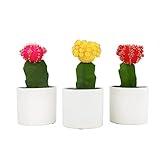
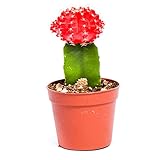
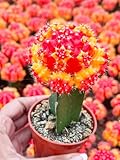
1 Comment
This is a great article. I have an orange moon cactus. Thank you!